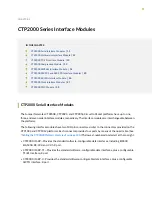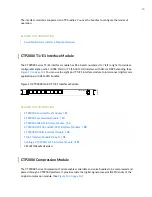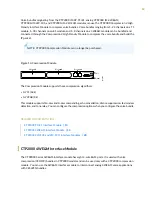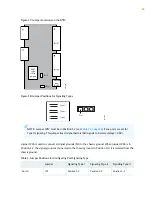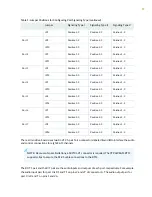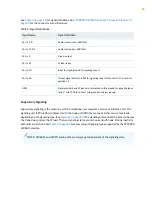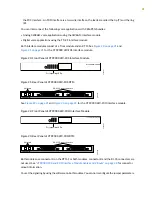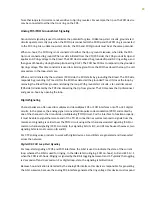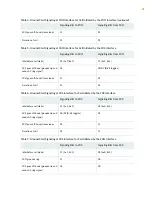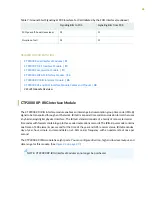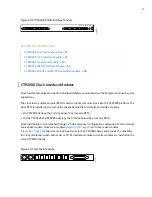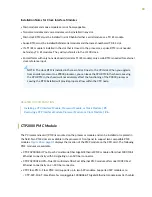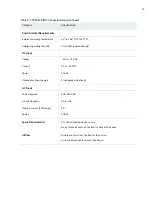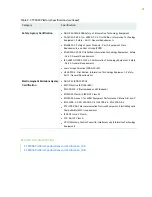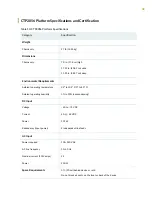
Note that loop-start circuits are not sensitive to tip/ring reversal. For example, the tip on the FXO device
may be connected to either the tip or ring on the FXS.
Analog FXS/FXO Ground-Start Signaling
Ground-start signaling is used to minimize the potential for glare. Unlike loop-start circuits, ground-start
circuits operate correctly only when the FXO tip is connected to the FXS tip and the FXO ring is connected
to the FXS ring. Also, unlike loop-start circuits, the FXS and FXO grounds must be at the same potential.
When on-hook, the FXO ring is not connected to either the tip or ground. Likewise, when idle, the FXS
tip is not connected to ground. When a call is initiated from the CO (FXS side), the FXS grounds its tip and
applies an AC ring voltage to the R lead. The FXO device senses the grounded tip and AC ring voltage, and
then goes off-hook by closing the loop (connecting R to T). The FXO has 100 ms to respond to the grounded
tip/ring voltage. This time constraint is used to minimize glare. Once the FXO has closed the loop, the call
proceeds as in the loop-start case.
When a call is initiated by the customer (FXO) side, the FXO starts by grounding the R lead. The FXS side
responds by grounding its T lead. After the FXO has detected the grounded T lead, it closes the loop by
removing the R lead from ground and closing the loop. With ground-start circuits, a far-end disconnect
(FXS side) is indicated by the FXS disconnecting the tip from ground. The FXO senses the tip disconnect
and goes on-hook by opening the loop.
Digital Signaling
Channel banks are often used to multiplex and demultiplex FXS or FXO interfaces onto T1 or E1 digital
circuits. In the process, the analog signal is converted into pulse code modulation (PCM) and carried by
one of the channels in the time-division multiplexing (TDM) circuit. For the interface to function properly,
it must be able to signal the remote end of the T1/E1 connection as well as respond to signals from the
remote end. Signaling is carried over the TDM circuit using either channel-associated signaling (CAS) or
common-channel signaling (CCS). Generally, four signaling bits (A, B, C, and D) may be used; however, two
signaling bits are most common (A and B).
For CTP analog voice products to work with digital devices, A and B bits are generated and transported
across the network.
Digital FXS/FXO Loop-Start Signaling
For loop-start signaling of FXS and FXO interfaces, the A bit is used to indicate the state of the current
loop, whereas the B bit is used for ringing. In the idle state (no ringing, FXO on-hook), A=0 and B=1. A=1
when the FXO is off-hook. Ringing is signaled by the B bit toggling between 0 and 1. Typically the toggling
is 2 seconds off and 4 seconds on. For digital loop-state, the signaling is bidirectional.
Because hook indication is detected by the analog FXS interface, this device is responsible for generating
the A bit. Likewise, because the analog FXS interface generates the ring voltage, this device must respond
23
Summary of Contents for CTP2000 Series
Page 1: ...CTP2000 Series Circuit to Packet Platforms Hardware Guide Published 2020 08 31 ...
Page 8: ...1 PART Overview CTP2000 Series Platform Overview 2 CTP2000 Series Interface Modules 11 ...
Page 112: ...Installing SFPs in a CTP2000 Module 102 105 ...
Page 127: ...5 PART Configuration Accessing the CTP2000 Platform 121 ...
Page 144: ...7 PART Troubleshooting Troubleshooting Power Failures 138 Contacting Customer Support 140 ...



